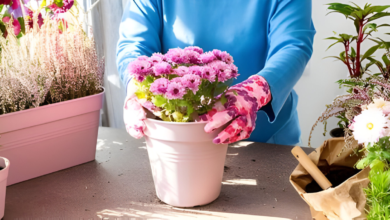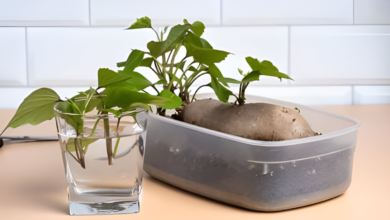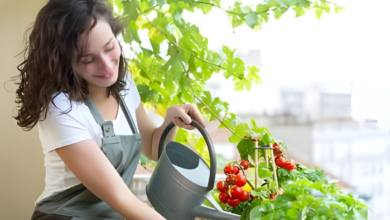Tips for Growing Beefsteak Tomatoes in Pots

Table of Contents:
- Choosing the Right Pot Size
- Selecting the Right Soil Mix
- Optimal Sunlight and Temperature Requirements
- Proper Watering Techniques
- Feeding and Fertilizing Schedule
- Support and Pruning Tips
- Preventing Common Pests and Diseases
- Harvesting and Storing Beefsteak Tomatoes
- Troubleshooting Common Problems
- Creative Recipes to Enjoy Your Homegrown Beefsteak Tomatoes
Choosing the Right Pot Size
When selecting a pot for your beefsteak tomatoes, size matters significantly. The pot size directly impacts the plant’s growth and overall health. Here are some tips to help you choose the right pot size for your beefsteak tomatoes:
- Opt for a 5-gallon container: Beefsteak tomatoes have large root systems and need ample space to grow. A 5-gallon container is the minimum size recommended for one beefsteak tomato plant.
- Consider larger pots for better growth: If you have the space, opt for larger pots, such as 10-gallon containers, to allow your beefsteak tomatoes to thrive. The additional space will provide more room for root growth and help prevent the plant from becoming root-bound.
- Ensure proper drainage: Regardless of the pot size, make sure it has drainage holes at the bottom to prevent waterlogging, which can lead to root rot.
- Evaluate your growing space: Consider the area where you will be placing the pots. If you have limited space, you may need to compromise on pot size. However, larger pots generally yield healthier plants and better harvests.
- Check for pot depth: In addition to the diameter, consider the depth of the pot. Beefsteak tomatoes have deep root systems, so choose a pot that is deep enough to accommodate their roots.
- Plan for staking or support: Beefsteak tomatoes are heavy plants that require support as they grow. Ensure that the pot size allows for staking or installing a cage to support the plant as it matures.
Choosing the right pot size is essential for successfully growing beefsteak tomatoes in containers. By selecting pots that provide adequate space for root growth, drainage, and support, you can help your plants thrive and produce bountiful harvests.
Selecting the Right Soil Mix
When growing beefsteak tomatoes in pots, choosing the correct soil mix is crucial for their success. Here are some tips on selecting the right soil mix:
- Well-Draining: I recommend using a soil mix that is well-draining to prevent waterlogging, which can lead to root rot. Look for mixes specifically labeled for containers or create your own mix using equal parts of potting soil, peat moss, and perlite.
- Nutrient-Rich: Beefsteak tomatoes are heavy feeders, so I suggest using a soil mix that is nutrient-rich. Consider incorporating organic matter like compost or aged manure to provide essential nutrients for the plants.
- pH Level: Check the pH level of the soil mix before planting your beefsteak tomatoes. They thrive in slightly acidic soil with a pH range of 6.0 to 6.8. You can adjust the pH level by adding lime to raise it or sulfur to lower it accordingly.
- Sterilized: Using sterilized soil mix can help prevent diseases and pests from affecting your beefsteak tomatoes. Look for sterile or pasteurized mixes, or you can sterilize the soil yourself by heating it in the oven at 180°F for 30 minutes.
- Moisture Retention: Opt for a soil mix that retains moisture well to ensure your beefsteak tomatoes stay hydrated properly. Adding vermiculite or coconut coir can help improve moisture retention in the soil mix.
By paying attention to these factors and selecting the right soil mix, you can provide your beefsteak tomatoes with the optimal growing conditions they need to thrive in pots.
Optimal Sunlight and Temperature Requirements
I recommend placing your beefsteak tomato plants in a spot that receives full sunlight for at least 6-8 hours each day. This will ensure that your plants get the necessary light to grow and produce fruit successfully. If you are growing the tomatoes indoors, consider using grow lights to supplement the natural light they receive.
Maintaining the right temperature is also crucial for the healthy growth of beefsteak tomatoes. Ideally, the temperature should stay between 70-85 degrees Fahrenheit during the day and above 60 degrees Fahrenheit at night. Fluctuations outside this range can stress the plants and affect fruit production.
To help regulate the temperature, consider using containers that have good insulation properties. Additionally, you can use mulch around the base of the plants to regulate soil temperature and retain moisture.
Remember to monitor the temperature regularly, especially during extreme weather conditions, to ensure that your beefsteak tomatoes are thriving in the optimal environment.
When it comes to sunlight and temperature requirements, providing consistent and appropriate levels will set your beefsteak tomato plants up for success.
Proper Watering Techniques
When growing beefsteak tomatoes in pots, proper watering is essential to ensure healthy plant growth and abundant fruit production. Here are some watering techniques that I find effective:
- Consistent Watering Schedule: I make sure to water my beefsteak tomato plants regularly to keep the soil consistently moist. Irregular watering can lead to issues like blossom end rot and cracked fruits.
- Deep Watering: Instead of giving the plants a shallow watering every day, I prefer to water deeply but less frequently. This encourages the roots to grow deeper into the soil, promoting a stronger and more drought-tolerant plant.
- Watering at the Base: I always water my beefsteak tomatoes at the base of the plant, avoiding wetting the foliage. This helps prevent fungal diseases and ensures that the water reaches the roots where it is needed most.
- Mulching: Mulching around the base of the tomato plants helps retain soil moisture and reduces the frequency of watering. I use organic mulches like straw or shredded leaves to also add nutrients to the soil as they break down.
- Monitoring Soil Moisture: I regularly check the moisture level of the soil by inserting my finger about an inch deep into the pot. If it feels dry, it’s time to water. If it’s still moist, I hold off on watering to prevent overwatering.
Proper watering is crucial for the success of beefsteak tomatoes in pots. By following these techniques, I ensure that my plants have the optimal growing conditions for producing juicy and flavorful tomatoes.
Feeding and Fertilizing Schedule
To ensure your beefsteak tomatoes thrive and produce an abundance of delicious fruit, it’s crucial to feed and fertilize them properly. Here is a schedule to help you keep your tomatoes healthy and thriving:
- Week 1-2: After planting, I begin by feeding my beefsteak tomatoes with a balanced fertilizer to provide essential nutrients for early growth. I choose a fertilizer with higher nitrogen content to promote strong foliage development.
- Week 3-4: As my tomatoes continue to grow, I switch to a fertilizer with higher phosphorus content to encourage root growth and flower production. I apply the fertilizer according to the package instructions, usually every two weeks.
- Week 5-6: Once my beefsteak tomatoes start setting fruit, I go back to a balanced fertilizer to support overall plant health and fruit development. I also supplement with a calcium-rich fertilizer to prevent blossom end rot.
- Week 7-8: During the peak fruiting period, I feed my tomatoes with a potassium-rich fertilizer to promote larger and sweeter fruit. I make sure to water my plants deeply after fertilizing to prevent nutrient burn.
- Week 9-10: As the end of the growing season approaches, I gradually reduce the frequency of fertilizing to allow the plants to start preparing for the dormant period.
Remember, always follow the instructions on the fertilizer package and adjust the feeding schedule based on the specific needs of your beefsteak tomatoes. With the right feeding and fertilizing regimen, you can enjoy a bountiful harvest of juicy, flavorful tomatoes from your container garden.
Support and Pruning Tips
When growing beefsteak tomatoes in pots, providing the necessary support is crucial to ensure the plants can thrive and produce abundant fruit. Here are some tips for supporting and pruning your beefsteak tomato plants:
- Sturdy Support: Choose a sturdy support structure such as a tomato cage, stake, or trellis to prevent the plants from bending or breaking under the weight of the fruit.
- Early Staking: I recommend staking your beefsteak tomato plants soon after planting to avoid damaging the roots later on. This will also help train the plants to grow vertically.
“Proper support early on can prevent issues like broken stems or branches as the tomatoes grow heavier.”
- Pruning Suckers: Regularly check your plants for suckers, which are small shoots that grow in the crotch between the main stem and branches. By removing these suckers, you can redirect the plant’s energy towards fruit production rather than foliage growth.
- Optimal Airflow: Prune the lower leaves of the plant to improve airflow and reduce the risk of diseases such as blight. This also helps the plant direct more nutrients to the fruit.
“Good airflow around the plant can prevent issues like mold and mildew, leading to healthier tomatoes.”
- Trimming Excess Foliage: While foliage is essential for photosynthesis, too much can hinder fruit development. I recommend trimming excess foliage to ensure the plant focuses its energy on fruit production.
Following these support and pruning tips can help you grow healthy and productive beefsteak tomatoes in pots.
Preventing Common Pests and Diseases
I always prioritize preventing common pests and diseases when growing beefsteak tomatoes in pots. Here are some essential tips to help keep your tomatoes healthy:
- Regularly inspect your plants: I make it a habit to inspect my tomato plants regularly for any signs of pests or diseases. Early detection is key to preventing any serious issues.
- Practice crop rotation: If you are growing tomatoes in pots year after year, consider rotating the location of your pots to prevent the buildup of pests and diseases in the soil.
- Provide proper spacing: Ensuring adequate spacing between tomato plants in pots can help improve air circulation, reducing the risk of diseases such as powdery mildew.
- Avoid overhead watering: Watering tomato plants at the base helps keep the foliage dry, which can prevent diseases like blight.
- Mulch around the base: Mulching around the base of your tomato plants can help regulate soil temperature and moisture, as well as prevent soil-borne diseases from splashing onto the plant.
- Use organic pest control methods: I prefer using organic methods such as neem oil or insecticidal soap to control common pests like aphids or caterpillars.
- Remove any affected leaves: If I notice any signs of disease on my tomato plants, I promptly remove the affected leaves to prevent the spread of the disease.
By following these tips and staying vigilant, I can effectively prevent common pests and diseases from affecting my beefsteak tomatoes grown in pots.
Harvesting and Storing Beefsteak Tomatoes
I prefer to harvest beefsteak tomatoes when they are fully ripe on the vine. This ensures the best flavor and texture. When picking the tomatoes, I gently twist them off the vine to avoid any damage. It’s essential to handle them carefully to prevent bruising.
After harvesting, I store the tomatoes at room temperature if I plan to use them within a few days. If I have a large harvest or want to keep them for a longer period, I store them in a single layer in a cool, dark place. This helps them last longer without spoiling.
To ripen green tomatoes, I place them in a paper bag with a ripe banana or apple. The ethylene gas produced by the fruit helps speed up the ripening process. Checking on them regularly ensures they ripen evenly and are ready to eat when desired.
When it comes to storing harvested beefsteak tomatoes, I avoid refrigerating them unless they are fully ripe and I plan to use them soon. Refrigeration can affect the flavor and texture of the tomatoes. However, if I have sliced tomatoes or leftovers, I store them in an airtight container in the refrigerator and use them within a few days.
Properly harvesting and storing beefsteak tomatoes ensures I can enjoy their delicious taste even after the growing season ends.
Troubleshooting Common Problems
When growing beefsteak tomatoes in pots, it’s common to encounter issues along the way. Here are some common problems you may face and how to troubleshoot them effectively:
- Yellowing leaves: If you notice your tomato plant’s leaves turning yellow, it could be a sign of nutrient deficiencies, overwatering, or pests. To address this issue, I recommend checking the plant’s watering schedule, adjusting fertilizer application, and inspecting the leaves for any signs of pests.
- Blossom end rot: This condition appears as dark, sunken spots on the bottom of the tomatoes and is caused by a calcium imbalance in the plant. To combat blossom end rot, I suggest ensuring consistent watering, providing adequate calcium through supplements or amendments, and maintaining proper humidity levels around the plant.
- Fruit cracking: Cracking in beefsteak tomatoes can occur when there is fluctuation in watering, leading to rapid fruit growth. To prevent fruit cracking, I advise maintaining a regular watering schedule, ensuring the soil is evenly moist but not waterlogged, and providing adequate mulch to retain moisture around the roots.
- Pests and diseases: Common pests that may affect beefsteak tomatoes include aphids, hornworms, and fungal diseases like early blight. I recommend regularly inspecting the plants for signs of infestation, using organic pest control methods if needed, and practicing crop rotation to prevent disease buildup in the soil.
By being proactive in identifying and addressing these common problems when growing beefsteak tomatoes in pots, I can ensure that my plants stay healthy and productive throughout the growing season.
Creative Recipes to Enjoy Your Homegrown Beefsteak Tomatoes
I enjoy finding new and creative ways to savor the juicy, flavorful beefsteak tomatoes that I grow in pots. Here are some delicious recipes that will make your homegrown beefsteak tomatoes the star of the dish:
- Caprese Salad: Layer thick slices of beefsteak tomatoes with fresh mozzarella cheese, basil leaves, a drizzle of balsamic glaze, and a sprinkle of salt and pepper.
- Tomato Bruschetta: Mix diced tomatoes with minced garlic, fresh basil, olive oil, balsamic vinegar, salt, and pepper. Serve on top of toasted baguette slices.
- Stuffed Beefsteak Tomatoes: Hollow out beefsteak tomatoes and fill them with a mixture of cooked quinoa, sautéed vegetables, and cheese. Bake until the tomatoes are tender and the filling is bubbly.
- Tomato and Avocado Salsa: Combine diced tomatoes, ripe avocado, red onion, jalapeno, cilantro, lime juice, salt, and pepper for a refreshing salsa to pair with tortilla chips.
- Beefsteak Tomato Pasta: Toss cooked pasta with a sauce made from blended beefsteak tomatoes, garlic, onion, basil, and olive oil. Top with grated Parmesan cheese before serving.
Experimenting with these recipes will showcase the amazing flavor of your homegrown beefsteak tomatoes and elevate your culinary experience. Enjoy the fruits of your labor in the most delicious ways possible!




